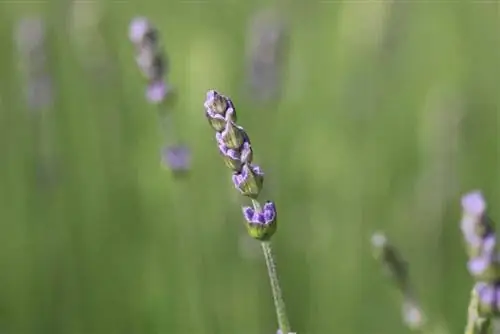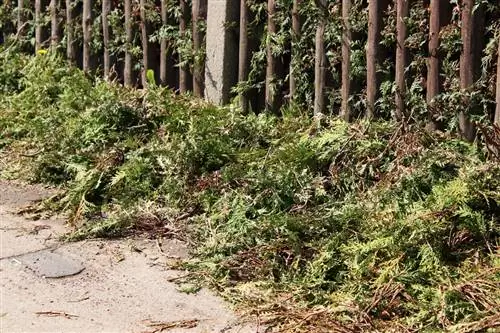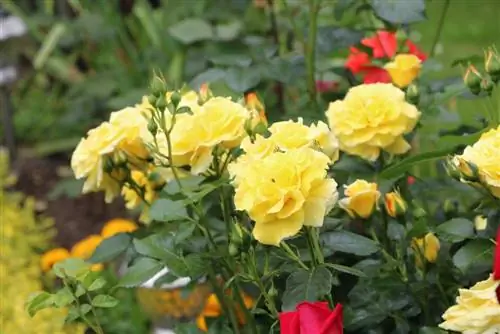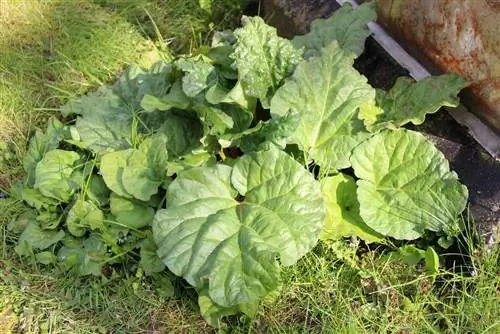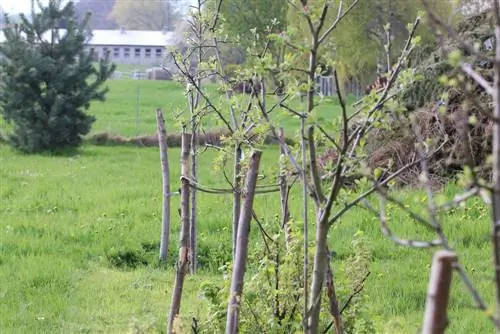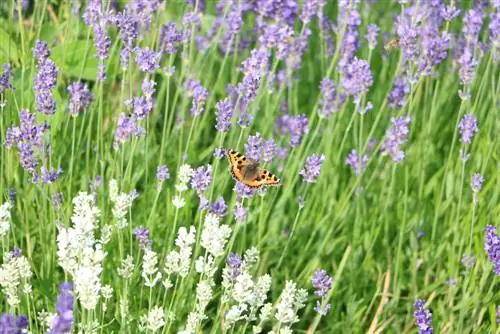- Author admin [email protected].
- Public 2023-12-17 03:39.
- Last modified 2025-06-01 06:48.
You can cut the lavender several times a year when there is no longer any threat of frost. When is the ideal time depends on how you use the bush or the cut parts.
Tool
Which tool you use depends on the type of pruning. It is generally important that the cutting tool is sharp and clean. Disinfection is usually not necessary unless the lavender itself has a disease that may be transferable to other lavender plants.
- Sickle
- Hedge trimmer (preferably a mechanical model)
- Pruning Shears
- Garden scissors
Note:
Although the open interfaces of lavender are not susceptible to bacteria or fungi due to its ingredients, unclean cut edges can cause unnecessary stress to the plants. You should therefore regularly sharpen the cutting tool you use.
Conservation cut
Carry out maintenance pruning twice a year. In spring the lavender bush is shortened by two thirds and in summer by one third. For maintenance pruning in spring, it has proven useful to choose a leading branch similar to fruit tree pruning. The leading branch serves, among other things, to ensure that the side shoots are evenly supplied with water in the spring. The budding and subsequent shoots are more even and a beautiful shape is retained. The right tool for maintenance pruning is secateurs. You should only remove very thick dead branches with pruning shears.
- choose a round and compact shape
- remove dead branches
- Just shorten the shoots, do not remove them completely
Note:
You can carry out maintenance pruning in summer after flowering or after harvest pruning.
Rejuvenation cut in spring
Older lavender bushes cannot be prevented from becoming woody over time. On the one hand, this is a good sign because the bushes feel comfortable in their location. On the other hand, parts that are woody also ensure that the bushes no longer bloom so luxuriantly and that they eventually become bald. In March, when there is no longer any forest, you should rejuvenate older bushes.
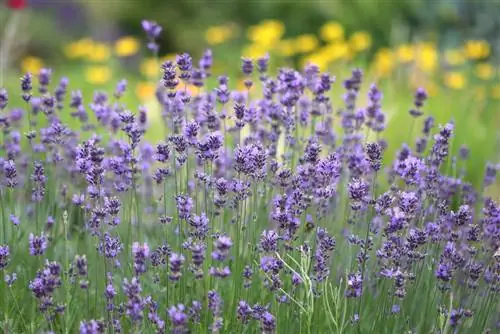
Compared to other trees, the lavender bush does not tolerate severe rejuvenation pruning. When removing old branches, you should proceed very carefully. The plants rarely sprout in a place that is already woody. That's why it's important not to let it get that far and to carry out regular topiary cuts.
However, if there is no other option, then just cut out a few woody parts in March. You should remove a maximum of two branches per season with strong pruning shears or secateurs.
The success of the rejuvenation cut depends heavily on the right time. In addition to spring, hobby gardeners have also had good success with pruning in the summer months. June and July seem to be promising as the lavender is actually in a reproductive phase with flowering at this time. A rejuvenation cut at this time also appears to encourage new growth from the woody areas.
Tip:
If you do rejuvenation pruning in spring, you can use the cut shoots as cuttings for new lavender bushes.
Crop cutting in summer
In addition to real lavender (Lavandula angustifolia), broad-leaved lavender (Lavandula latifolia) is also used in a variety of ways. If you not only have lavender bushes as a decorative perennial in the garden, but also want to process the pruning further, you should pick the right time to harvest the flowers. It is best to cut the lavender bushes with a sickle. Although pruning with a sickle seems a bit rough, it is the easiest way to harvest the flowers. The right time to cut the harvest is when the first flowers of the spikes open, but the majority are still closed.
- bundle inflorescences
- approx. Cut off 15 - 20 cm below the ear with the sickle
- Cut off very short inflorescences above the leaves
Tip:
If you don't have or don't want to use a sickle, large scissors are also suitable for harvesting the lavender ears.
The goal of harvest pruning is to harvest the flowers. However, this means that there are still stem residues that need to be removed. The easiest way to do this is to trim again with hedge trimmers.
Cut in summer
If the flowers are not harvested, you should cut the lavender plants after they have bloomed at the latest. The formation of seeds costs the perennials a lot of energy. Therefore, you should not wait so long and cut it in time. When pruning after the first flowering, you can cut a little more generously. This promotes the formation of new flowers, which will, with a bit of luck, allow it to bloom again in the fall. A hedge trimmer is suitable for trimming after flowering. However, make sure that you get the lavender's even shape.
Pruning in autumn
If the lavender bushes bloom again in late summer, they can be pruned again in the fall. At this point, only spent inflorescences are removed. If the lavender is still blooming, don't hesitate to cut the flowering spikes too. If you wait too long before pruning, frost can damage the bushes.
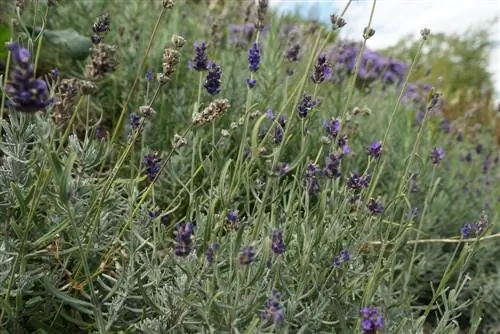
Pruning should be done by September at the latest. This gives the bushes enough time to recharge their batteries for the winter and also for the coming season. When or whether pruning can take place in autumn depends on the climatic region. You should only think about a second pruning in autumn in regions with a favorable climate. If you are too late and low temperatures are already approaching early, it is better not to prune. It may not bloom quite as profusely next year, but there is less risk of frost damaging the plants.
Tip:
You should also avoid cutting cuttings again in the autumn months if there is a risk of frost. The months of March or April are better suited for this.
Cutting shape / topiary
The spherical shape dominates lavender bushes. This not only looks good, but also has a practical use. The spherical shape encourages the lavender to sprout again in the lower area. This allows you to form robust and compact bushes over the years. If the lavender bushes are completely out of shape, a radical shape cut should be carried out in spring. However, it is important to give the bushes a shape and, if possible, not to penetrate too far into the old wood.
Avoid mistakes
As beautiful as the lavender bushes bloom, they are so time-consuming to cut. They don't forgive mistakes, if at all. Therefore, you should consider a few points when pruning.
- Avoid cuts in old wood
- Avoid pruning when frost is imminent
- pruning too timidly
- No pruning
- unsuitable or blunt cutting tool
- dirty cutting tool
- Pruning in heat/sun
The biggest mistake with lavender bushes is not pruning them at all. Because this threatens to cause the bushes to become bare. Therefore, you should prune at least once a year. In addition, you should not prune when the sun is shining on the bushes. You will immediately notice the intense essential oils of lavender when you cut it. Open interfaces in combination with high temperatures promote the escape of essential oils. However, these are protective substances for the plant, with which it protects itself against fungi and bacteria, for example. In addition, the plants can suffer sunburn at the interface.
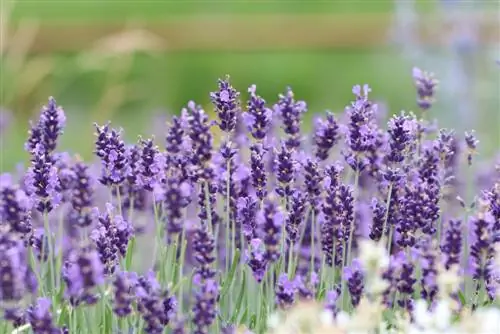
Better times of day are early morning or late afternoon. If the bushes are temporarily shaded, you can also prune at another time when the shadow falls on the bushes for a longer period of time. It is best to prune on a cloudy day so that the bushes have several hours to recover from the cut.

